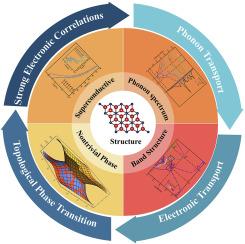ZrCl单层中强电子相关驱动的拓扑超导性和奇异输运性质
IF 9.7
2区 材料科学
Q1 MATERIALS SCIENCE, MULTIDISCIPLINARY
引用次数: 0
摘要
具有非平凡拓扑结构和鲁棒无耗散边缘态的低维拓扑超导体被广泛认为是实现可靠量子信息处理的关键物理平台。结合第一性原理计算和数值模拟,我们通过非平凡的Z2拓扑不变量(Z2 = 1)确定了ZrCl单层为拓扑超导体。我们的研究表明,ZrCl是一种强耦合的拓扑超导体,具有两个能隙(Δα =2.45 meV, Δβ= 3.1 meV)和12.3 K的高超导转变温度。在Bogoliubov-de Gennes理论框架内的进一步分析表明,在特定范围(- 0.13 < μ < 1.2 meV)内调整化学势可以诱导空间对称性破缺,从而触发能带反转和拓扑相变。有趣的是,系统中的电子-声子耦合(EPC)通过产生自困激子(STEs)进一步增强了其边缘态的输运性能,其中STEs与横向光学声子之间的相互作用使边缘态能量重新规范化。这些结果揭示了拓扑保护机制和晶格动力学之间的深刻协同作用,使ZrCl单层中具有鲁棒边缘模式的量子态得以调节。这为面向容错量子比特和高灵敏度拓扑器件的材料设计开辟了一条新途径。本文章由计算机程序翻译,如有差异,请以英文原文为准。

Strong Electronic Correlation-Driven Topological Superconductivity and Exotic Transport Properties in ZrCl Monolayer
Low dimensional topological superconductors with nontrivial topological structures and robust dissipationless edge states are widely regarded as a pivotal physical platform for realizing reliable quantum information processing. Combining first-principles calculations and numerical simulations, we identify the ZrCl monolayer as a topological superconductor, evidenced by a nontrivial Z2 topological invariant (Z2 = 1). Our research demonstrates that ZrCl is a strongly coupled topological superconductor with two energy gaps (Δα =2.45 meV, Δβ= 3.1 meV) and a high superconducting transition temperature of 12.3 K. Further analysis within the Bogoliubov-de Gennes theoretical framework reveals that tuning the chemical potential within a specific range (−0.13 < μ < 1.2 meV) can induce spatial symmetry breaking, thereby triggering band inversion and topological phase transitions. Intriguingly, electron-phonon coupling (EPC) in the system further enhances the transport performance of its edge states by generating self-trapped excitons (STEs), where the interaction between STEs and transverse optical phonons renormalizes the edge state energies. These results uncover the profound synergy between topological protection mechanisms and lattice dynamics, enabling the regulation of quantum states with robust edge modes in the ZrCl monolayer. This opens a new path for material design oriented toward fault tolerant qubits and highly sensitive topological devices.
求助全文
通过发布文献求助,成功后即可免费获取论文全文。
去求助
来源期刊

Materials Today Physics
Materials Science-General Materials Science
CiteScore
14.00
自引率
7.80%
发文量
284
审稿时长
15 days
期刊介绍:
Materials Today Physics is a multi-disciplinary journal focused on the physics of materials, encompassing both the physical properties and materials synthesis. Operating at the interface of physics and materials science, this journal covers one of the largest and most dynamic fields within physical science. The forefront research in materials physics is driving advancements in new materials, uncovering new physics, and fostering novel applications at an unprecedented pace.
 求助内容:
求助内容: 应助结果提醒方式:
应助结果提醒方式:


